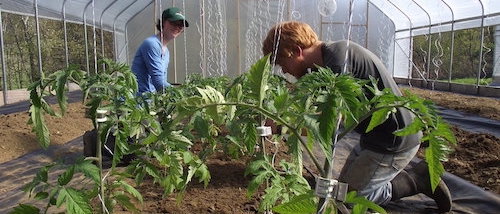Sometimes it feels like my flower farm, Moonshot Farm in East Windsor, New Jersey, is an entomologist’s dream and a farmer’s nightmare. Surrounded on all sides by conventionally sprayed farms, our property is an oasis for all kinds of cut flower pests. We grow the majority of our highest value stems under cover — both heated and unheated greenhouses — where pest issues can be magnified.
During our first few years, we had some extreme losses due to infestation. While organic vegetable consumers may accept a degree of bug damage or stowaways that can be rinsed off, most cut flower customers demand perfect flowers without bugs on them. We’ve tried a lot of techniques and made a lot of mistakes, but we are finally in a place where we feel like we generally have a handle on pest management. Here’s how we are managing major pests on our cut flower farm, aiming to be as environmentally friendly as we can without sacrificing quality.
Scouting
The most important task I do as a farm owner is take a weekly walk each Sunday with the specific goal to scout for pests. As our farm has grown, I’m not always the one who is hands-on managing our crops daily, so these walks have become even more important. During the walk, I note to-dos, look for issues, and, critically, look for pests and any signs of them. This usually means getting down at plant-level and inspecting stems, flowers, and undersides of leaves. I’ll often sacrifice some flowers and open up underdeveloped buds to look for bugs hiding inside.
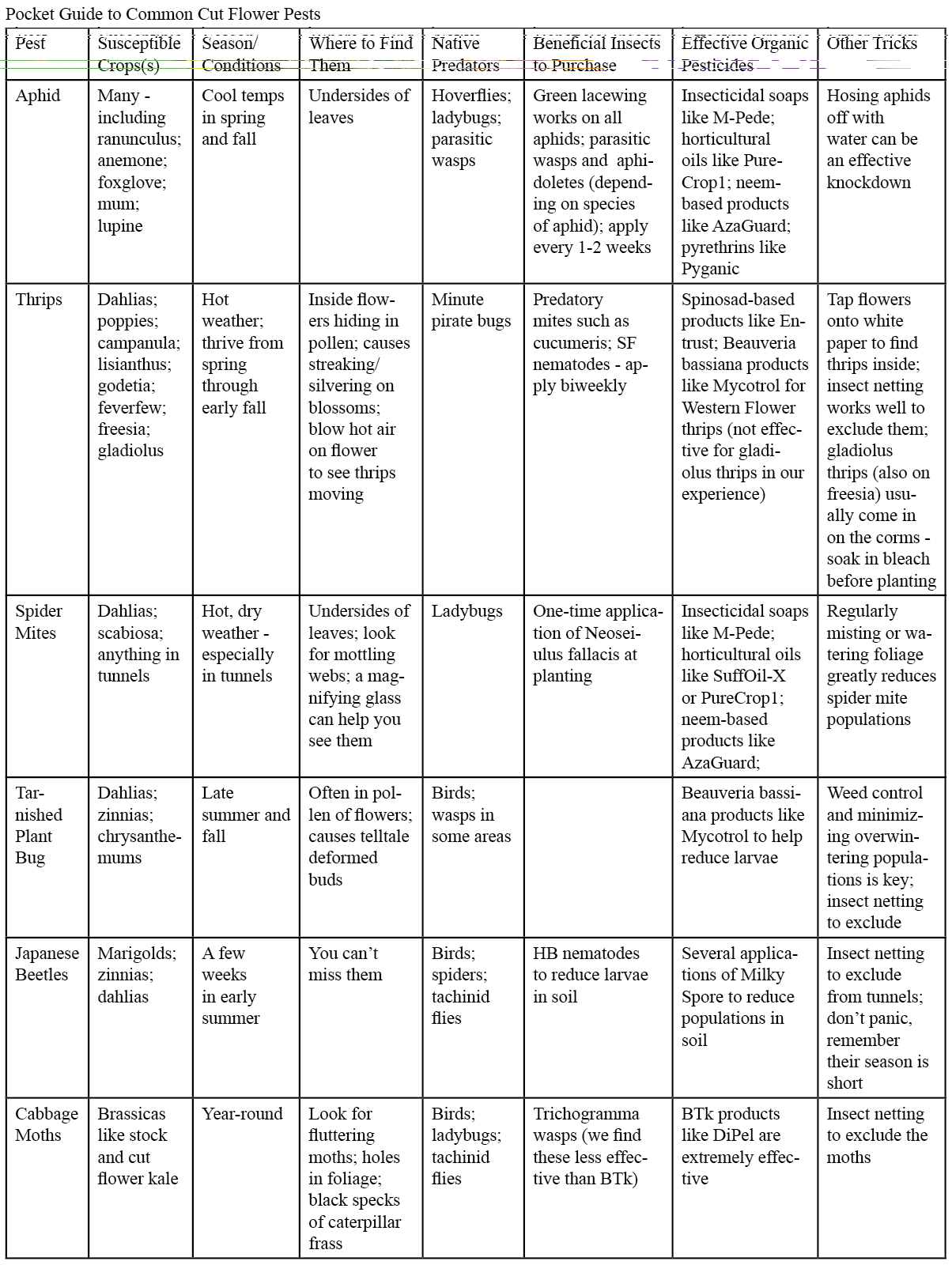
Our farm occasionally uses blue and yellow sticky traps, which can capture flying insects and help you to spot them. But we find these traps also capture (and kill) beneficial insects, get dirty fast, and can be expensive to use consistently. Carefully inspecting plant tissue for pests — and signs of pests — has been an effective alternative for us.
Scouting also means looking for native predators, whose presence usually means their pest food is nearby. If we see a sudden boom of hoverflies or ladybugs, we know that aphids are likely present. Likewise, a boom of orius (AKA minute pirate bugs) usually means that we have thrips.
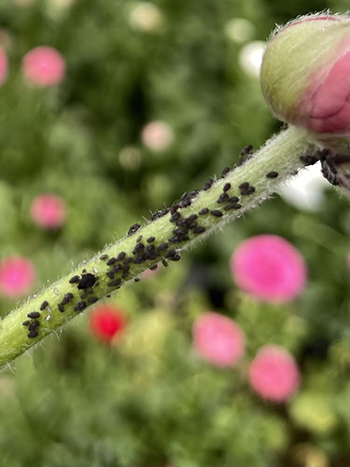
Proper identification of aphid species is critical to control. Our extension office helped us identify black bean aphids (above) and cotton melon aphids (below), both of which infest a wide variety of cut flower crops.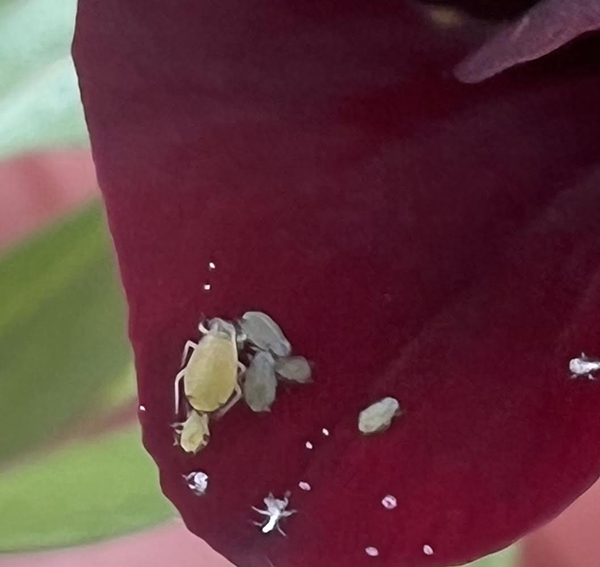
The damage caused by pests is also important to look for and recognize. Thrips cause streaking on flower petals and leaves. Spider mites cause brownish leaves and webbing. And aphids can cause a leaf curl that resembles herbicide damage. If we notice any of this damage, we investigate further to look for the cause.
Once you find a pest (or a beneficial insect), a correct identification is crucial, as knowing the specific species enables proper control. Certain species of aphids, for example, have different predators than others and respond differently to pesticides. While there are many great insect identification apps now (my favorite is Picture Insect), we find they work best for larger insects like Japanese Beetles.
To get a confident ID for smaller pests like aphids and thrips, as well as insect eggs and larvae, our local extension office has been a great help. Our beneficial insects supplier, Evergreen Growers, has also been excellent at identifying what we’re seeing. And finally, there are some great online forums and Facebook groups (the group “Insect Identification” is my favorite) where you can get help identifying insects, often from experts.
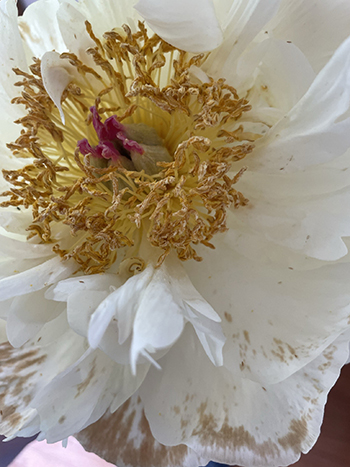
Thrips and thrips damage on a peony.
We keep a log in a simple Google Form of what pests we’re seeing, on what crops, where on the farm, and when, as well as recent weather conditions. This log enables us to predict pest infestations the next season. For example, with the log as a guide, we know that we’ll have an aphid eruption on our foxglove by late February, that cabbage moths will come for our cut flower kale by mid August, and that thrips will take over as soon as we have two days of 80°F degree weather. This informs future years’ approaches to pest management and helps us to adopt a proactive, rather than a reactive, method.
Using beneficial insects
Our approaches to pest management have become more aggressive over the years, as our family now relies on our farm for our income. In our earliest years, we naively thought we could rely only on the natural ecosystem to help keep pests at bay. This included attracting birds by planting shrubs and setting out birdbaths, improving our soil health to foster more resilient plants, and planting insectary plants like sweet alyssum to attract native predators.
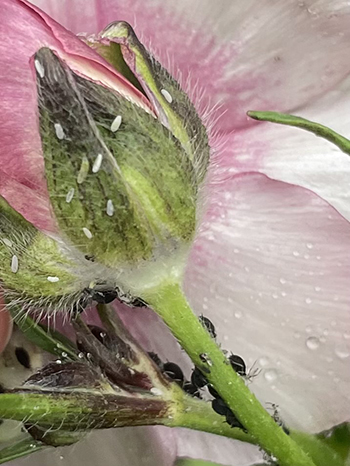
Recognizing signs of native beneficials is important, too. Rice-like hoverfly eggs and their worm-like larvae can easily be mistaken for pests, yet are voracious aphid predators.
This worked to a degree, especially for some field-grown flowers, but a commercial farm is inherently not a natural ecosystem. With high tunnels and heated greenhouses in the mix, pest control becomes quite complicated as we’ve essentially created multiple climates. For example, our extension agent tells us that thrips should be unable to survive New Jersey’s cold winters, but we see thrips overwintering in our high tunnels where the soil does not freeze. Additionally, many pests we encounter, such as Japanese beetles and Western Flower Thrips, are not native species in our area. Native predators just couldn’t keep up.
Buying in additional beneficial insects has been a huge help in managing our pest populations. Beneficials suppliers like Evergreen Growers, Arbico, and IPM Labs can help build a program for you. Many offer discounts if you set up regular shipping. Regular shipping will also ensure the insects are coming when you need them.
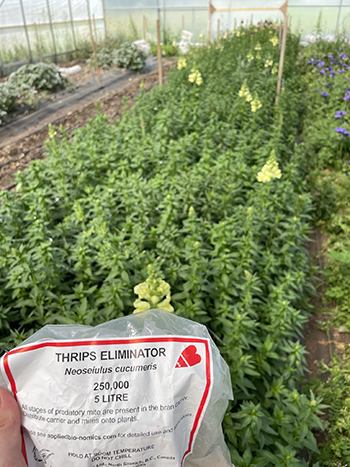
Sprinkling predatory mites and spraying Sf nematodes biweekly has helped us manage thrips.
When we first started managing pests, we would usually notice the pest, spend a few days researching it, order the beneficial insects, then wait a week (sometimes two) for them to arrive. In the meantime, pest populations ballooned past the point where beneficials could not control them. Setting up regular shipments, proactively based on when we anticipate pests will build up, has greatly improved their effectiveness.
Another one of our biggest mistakes when we first started using beneficial insects was not applying them frequently enough. During times of high or anticipated pest pressure, we now release beneficials as often as every week. This can get expensive fast, so choosing the right beneficial insects for your environment is key.
It’s also important to test your beneficial insects for viability before applying; otherwise, you might just be applying expensive dust.
For aphids, we find the most effective and economical method of control is to release green lacewing eggs every one to two weeks from March through October. The eggs ship in a small cup and can be mixed into a medium like vermiculite for easy application. We like to let the eggs sit in their package for a day or two to ensure they start hatching before we start releasing them into our crop. Parasitic wasps are also excellent for aphid control, but it’s important to choose the right one for your specific species of aphid.
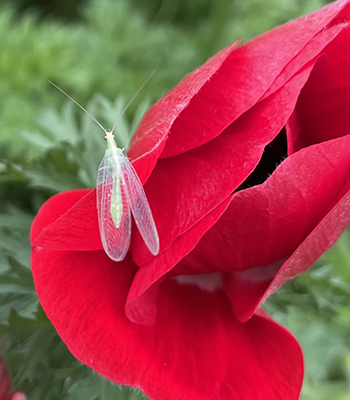
An adult lacewing on an anemone. Releasing lacewing eggs biweekly has helped us control all species of aphids.
For thrips, we swear by predatory mites such as Neoseiulus cucumeris. For a long time, we bought these in slow-release sachets which could be hung individually on plants. This was time consuming work and quickly became everyone’s least favorite farm chore. We’ve switched to buying the mites by the large bagful and shaking them onto the crop every two weeks during times of high thrips pressure. Before applying the mites, we check with a magnifying glass to ensure they are moving around.
We also rely on beneficial nematodes for thrips control. For Western Flower Thrips, we apply nematodes both to the soil and to the foliage, where thrips eggs and larvae can be found, every two weeks year-round. We mix a small sample of nematodes and water to look at them under a high-powered magnifying glass before applying to ensure we see them wiggling around.
Last year we invested in a Dosatron for applying beneficial nematodes to the farm. The device mixes and injects them in-line to a garden hose. We put the nematodes in a bucket of water and use an aquarium aerator to help keep the water agitated. We used to use a small hose-end sprayer for application but found it clogged quite easily from the goopy nematodes. This new system is a lot easier and more effective.
Thrips species can be tricky to distinguish, so it’s important to talk with an expert. Other types of thrips such as echinothrips and gladiolus thrips may require different controls.
There are dozens of different beneficial insects to experiment with depending on your pest, your climate, and your scale. The best thing I can recommend is to develop a strong relationship with a beneficials supplier and your extension office to help you choose the right ones.
We grow cut flowers 52 weeks a year and initially tried to use beneficial insects all through the winter. After a pest-infested first winter growing, we learned that most beneficials do not remain active during short days and cool temperatures. We now apply beneficials only from March through October when the days are long enough to keep them effective at eating up pests.
One exception is nematodes, which we apply all winter long. We even apply nematodes a few times in the winter to the field, if we get a week without freezing temperatures. They will help reduce populations of overwintering thrips in perennial crops like peonies.
Physical controls
One of the most impactful changes we have implemented for pest control is adding insect netting to our high tunnels. We use a very fine “thrips netting,” adding it into the wiggle wire channels. We also have screened our doors with the netting to enclose the entire tunnel. The netting does limit airflow, so we use it only from April through September, when our thrips pressure is at its worst. We take it down during the winter when airflow is critical to plant health.
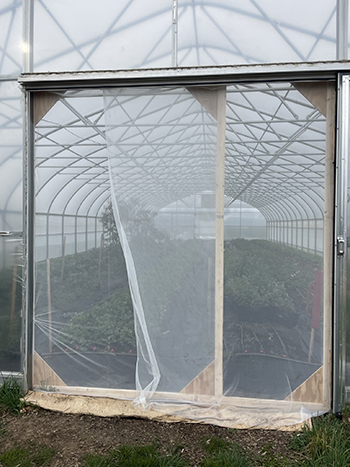
Installing insect netting on our high tunnels has dramatically improved pest pressure from flying insects.
The netting serves two purposes: it helps to exclude pests such as thrips and cabbage moths, while also helping to keep beneficial insects contained on a target crop. On the down side, the netting can limit populations of native insects from getting inside the tunnels, so we only use it in conjunction with beneficials and/or pesticides (more on that below).
Another physical control we’ve been experimenting with is reflective silver mulch, which can deter insect pests. We have tried growing dahlias in the silver mulch and seen a great improvement in thrips populations.
Pesticides
Our farm has gradually moved away from a “no sprays, ever” doctrine to the occasional and mindful use of pesticides, opting for those that are organic-allowed and trying to use less environmentally harmful options. We adopted this approach after throwing out so many flowers due to pests, including a beautiful crop of winter ranunculus infested with black bean aphids.
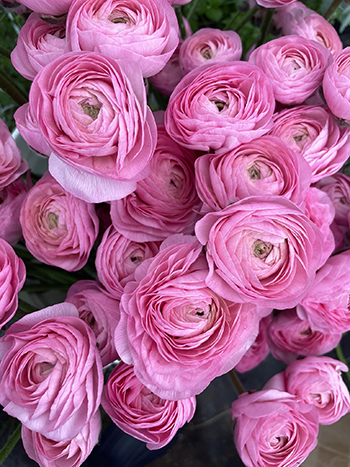
Ranunculus are one of our pest-prone crops but with careful management we now successfully grow thousands a year without pests. All images courtesy of the author.
After buying the expensive ranunculus corms from Italy, using pricey inputs including ineffective beneficial insects, and paying to heat them in the winter, it felt so wasteful to compost all of the blooms due to aphids. If we could minimally spray an organic-allowed pesticide to kill the aphids and save the crop, that actually felt more sustainable in many ways. In the winter, in our greenhouses, we see zero native beneficial insects, so it also felt less ecologically harmful.
Today, we occasionally use organic-allowed pesticides in the winter months. We’re mindful about rotating pesticides, following labels, and spraying only at night, and have a pesticide applicator license which is required here in New Jersey for even the most benign substances. We will also occasionally spray field crops during the main growing season, usually only once or twice early on to knock down a pest.
We generally try to avoid broad pesticides like pyrethrins, and opt for botanical and biological pesticides instead, as these seem to be less harmful to insects and animals. For example, spraying our first dahlia buds with a mix of Azagard and Mycotrol seems to knock down the cucumber beetles and thrips enough for the native predators to keep them in check the rest of the season.
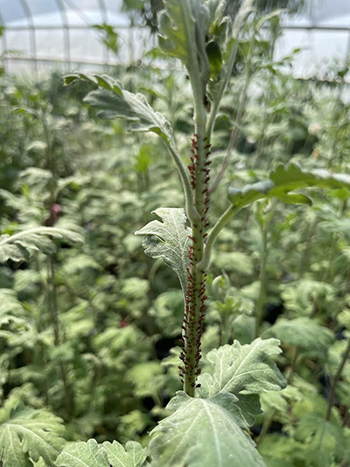
Many types of aphid, like these chrysanthemum aphids, infest only one type of plant.
While organic pesticides are not systemic, I was surprised to learn from our insect supplier that they can have some residual impact on beneficial insects. At the advice of our supplier, we now usually wait at least one to two weeks after a knockdown spray before we start releasing beneficials.
By far our favorite tool for applying pesticides in greenhouses and high tunnels is our fogger, which we got from Nolt’s. We set the fogger up at night, leave the tunnel, and then it releases the pesticide as a very fine mist. The fogger lets us use a smaller amount of the pesticide than we would need with a backpack sprayer and gets extremely thorough coverage, including underneath leaves and deep inside blooms. We also use this tool for applying fertilizers like kelp and calcium, and for organic fungicides. It’s been a game changer for our farm.
This approach of releasing beneficial insects from March through October, switching to occasional pesticides during the winter, and weekly scouting with proactive management has completely changed how pests impact our flower farm. While we still see infestations, we are more often a step or two ahead of the insects now, with the right beneficials already on the way or the right pesticides in our cabinet. It’s early March as I’m writing this article, a time when aphids usually take over our ranunculus. Instead, this year, we’re harvesting pristine, insect-free stems — without using any systemic chemicals.
Rebecca Kutzer-Rice owns Moonshot Farm, a specialty cut flower farm in East Windsor, NJ. She grows flowers year-round including in a geothermal greenhouse, for retail markets in and around NYC.
